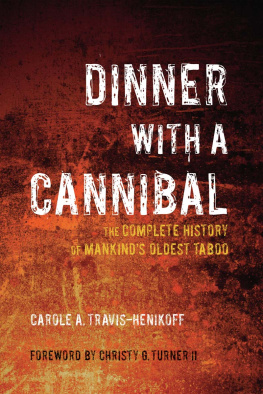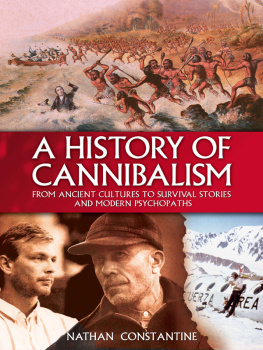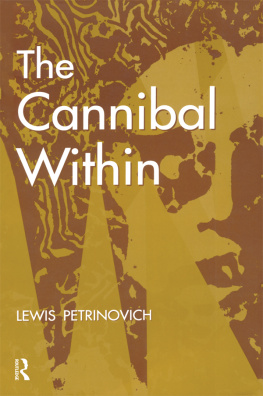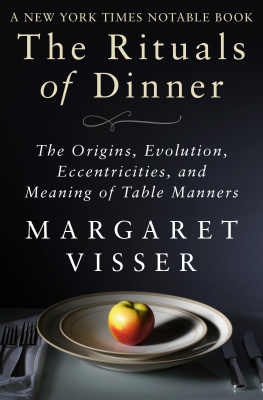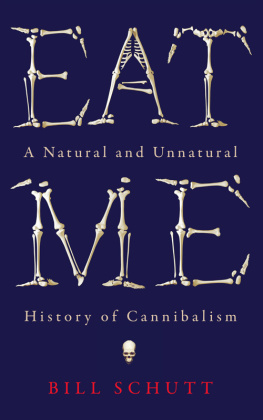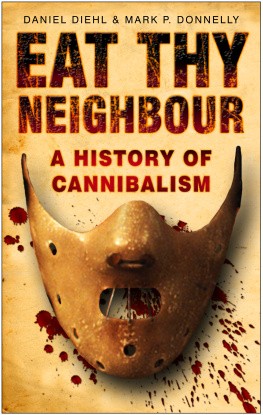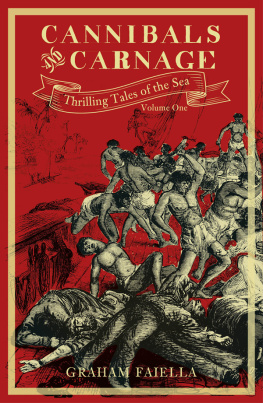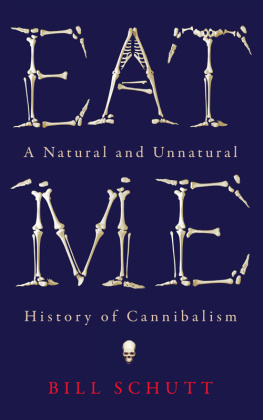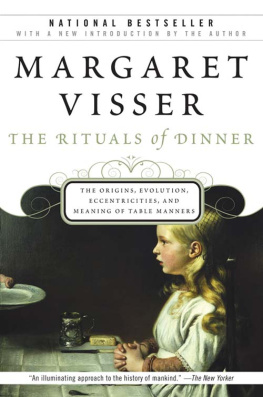
Copyright 2008 by Carole A. Travis-Henikoff
All rights reserved.
This book may not be reproduced in whole or in part or in any form or format without the written permission of the publisher.
 | Published by: Santa Monica Press LLC |
| P.O. Box 1076 |
| Santa Monica, CA 90406-1076 |
| 1-800-784-9553 |
www.santamonicapress.com
Printed in the United States
Santa Monica Press books are available at special quantity discounts when purchased in bulk by corporations, organizations, or groups. Please call our Special Sales department at 1-800-784-9553.
ISBN-13 978-1-59580-030-5
ISBN-10 1-59580-030-1
Library of Congress Cataloging-in-Publication Data
Travis-Henikoff, Carole A.
Dinner with a cannibal : the complete history of mankinds oldest taboo/by Carole A. Travis-Henikoff ; foreword by Christy G. Turner II.
p. cm.
Includes bibliographical references and index.
ISBN 978-1-59580-030-5
1. Cannibalism. 2. Taboo. I. Title.
GN409.T73 2008
394.9--dc22
2007041548
Cover and interior design and production by Future Studio
Illustrations by Bryan Duddles
CONTENTS
To my father, Carl Fredrick Sigvaard Andersen, who taught me the wonders of reading and research.
And to my mother, Caroline Faunce Andersen, who always said, You are what you eat and think.
ACKNOWLEDGMENTS
D inner with a Cannibal is the culmination of seven years of fascinating research. Throughout, and prior to, those years of investigation, there were friends and professionals who encouraged me, aided me, guided me, questioned me and stood by with words of knowledge and wisdom.
I wish to thank:
Ann Evans Berthoff, professor emerita, University of Massachusetts, Boston, who reviewed and edited my work as chapters took form. Her critical eye, humor, enthusiasm and encouragement were invaluable. On the day I met her she read the chapter entitled Dinner with a Cannibal. Looking up she said, This is the title of your book. And so it is.
Christy G. Turner II, Regents Professor of Anthropology, Arizona State University, author of Man Corn, and leading researcher on the subject of cannibalism, provided in-depth editing and information. His help, advice and knowledge are greatly appreciated.
Dr. Garniss Curtis, professor emeritus of geology, University of California, Berkeley, for long hours of reading, his dedication to accuracy, his integrity and, most of all, for his friendship over the course of many years.
Professor Ralph Holloway, Department of Anthropology, Columbia University, for his constant encouragement and for keeping me on track and never letting me give up.
Dr. Alan J. Almquist, California State University, Hayward, Department of Anthropology, author and former grants and programs officer for the L.S.B. Leakey Foundation, provided substantive editing and relevant commentsI owe him dinner.
Others who made a difference are the following professors, authors, professionals and mentors in the fields of paleoanthropology, archaeology, gastronomy, primatology, brain research, psychiatry, geology, genetics, law, particle physics and religion: John Morgan Allman, Juan Luis Arsuaga, Berhane Asfaw, Jean Auel, Carol Beckwith, Ron J. Clarke, Anna Belfer-Cohen, Leigh Bienen, Robert Bloominshiem, C.K. Brain, Alison Brooks, Larry Burton, Frank Brown, Daniel Buxhoeveden, Basil Cooke, John Costello, Eric Delson, Harold Dibble, Jan Fawcet, Angela Fisher, Jacob H. Fox, Birute M.F. Galdikas, Jane Goodall, Lance Grande, Jack Harris, Henry Harpending, Erima Henare, Kevin D. Hunt, Donald C. Johanson, Jean Joho, Alan Kahn, Leon Lederman, Rena Lederman, Roger Lewin, Shirley Lindenbaum, Alan Mann, Ian McDougall, William McGrew, James F. OConnell, Yoel Rak, Rudy Raff, William Rice, Kathy Schick, Sileshi Semaw, Gabino Sotelino, Dietrich Stout, Carl Swisher, Ian Tattersall, Alan Thorne, Phillip Tobias, Nicholas Toth, Jill Van Cleave, Paola Villa, Tim White, Hans Willimann, Milford Wolpoff and John Yellen.
And in remembrance: J. Desmond Clark, Betty Baume Clark, F. Clark Howell and Raymond Dart.
To Joan Travis, without whom I could have never entered into the inner sanctum of paleoanthropology, I owe an unpayable debt of gratitude.
And to my Australian friend, Alex Harris, who, in 1998, gave me the book Cannibals, Cows & the CJD Catastrophe, which inspired the formulation of a hypothesis concerning the demise of the Neanderthals, which, in turn, prompted research into the topic of cannibalism that led to the writing of this booka very large thank you indeed.
I am also indebted to Susan Heffron and Gretchen Notzold of the Teton County, Wyoming branch library in Alta, who pulled through with out-of-print volumes; Michael Harrison and Therry Frey for loaning me their unique volumes on New Guinea; Dr. Michael Huckman for allowing me time with his prized volumes, John McCarter for use of the Field Museums library; and David Coolidge for sending me the book Flyboys by James Bradley.
Last, but never least, go hugs to my husband, Dr. Leo M. Henikoff, a harsh, unflagging editor who stood byor went fishingthrough more than seven years of research, travel and writing even though, during the first two years of this project, he referred to me as The Ghoul, and in the same breath, asked when dinner would be ready.
And of course, there is my publisher, Jeffrey Goldman, whose excitement, talents and dedication to the publication of Dinner with a Cannibal proved to be prodigious.


FOREWORD
by Christy G. Turner II

D inner with a Cannibal is a terrifically well-written, exhaustively researched, and frequently chilling story of humankinds ancient and modern murderous consumptive behavior. Inspired by her master chef father, and plentifully versed in human prehistory, Carole A. Travis-Henikoff previously wrote a highly praised cookbook, followed, naturally it seems to me, by this more anthropological dietary account. Such accounts have, until recently, usually been shrouded by heavy-blanketing taboo.
It has often been said in various ways that we are all prisoners of our own experience. That which we know little or nothing about is commonly disbelieved, and sometimes considered a dangerous and taboo subject. Of all the taboo topics at one time rarely discussed in an open fashioncancer, death, sexual behavior, witchcraft, many othersthe topic of cannibalism remains among the last to shed its taboo imprisonment. Human cannibalism is rarely talked about except briefly in some college-level anthropology classes, although it has long been a subject for cartoon art depicting fat, pith-helmeted jungle explorers about to be cooked in a large iron potusually a racist jibe at tropical Africans. While I know of some other recent book-length writings on cannibalism, Dinner with a Cannibal is the broadest and most up-to-date work to break the hold taboo has on the subject. Oddly, starting in 1979, its taboo status actually increased because of an anthropologist named William Arens. Arens claimed cannibalism has never been witnessed by reliable observers, and therefore likely occurred only in occasional starvation or sociopathic situations. That claim has since been refuted over and over in recent years but just in rather inaccessible scholarly journals. Certainly none of these publications can be found in street-corner or airport bookstands. It is this body of recent and earlier scholarly literature that is broadly and carefully synthesized by the author.
Next page
